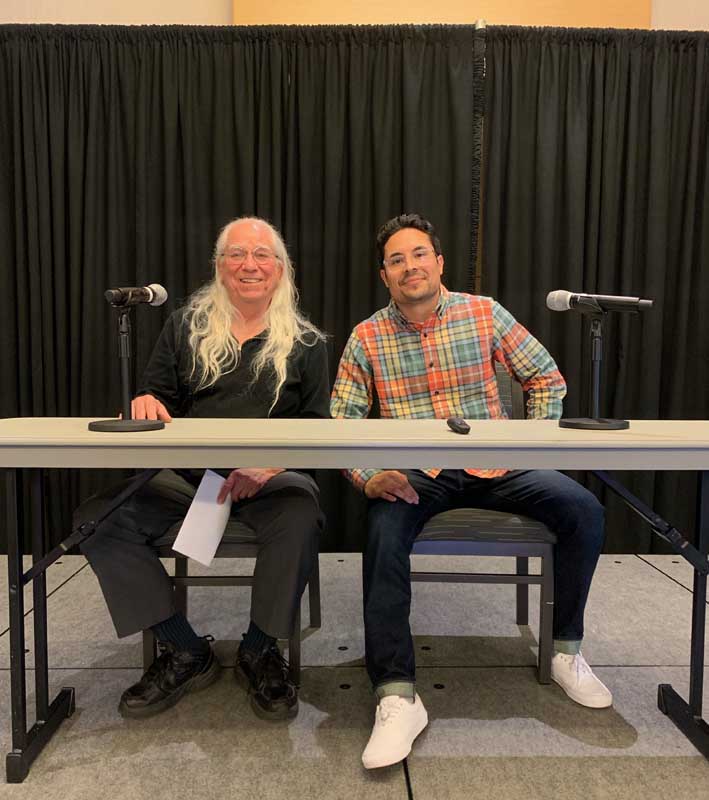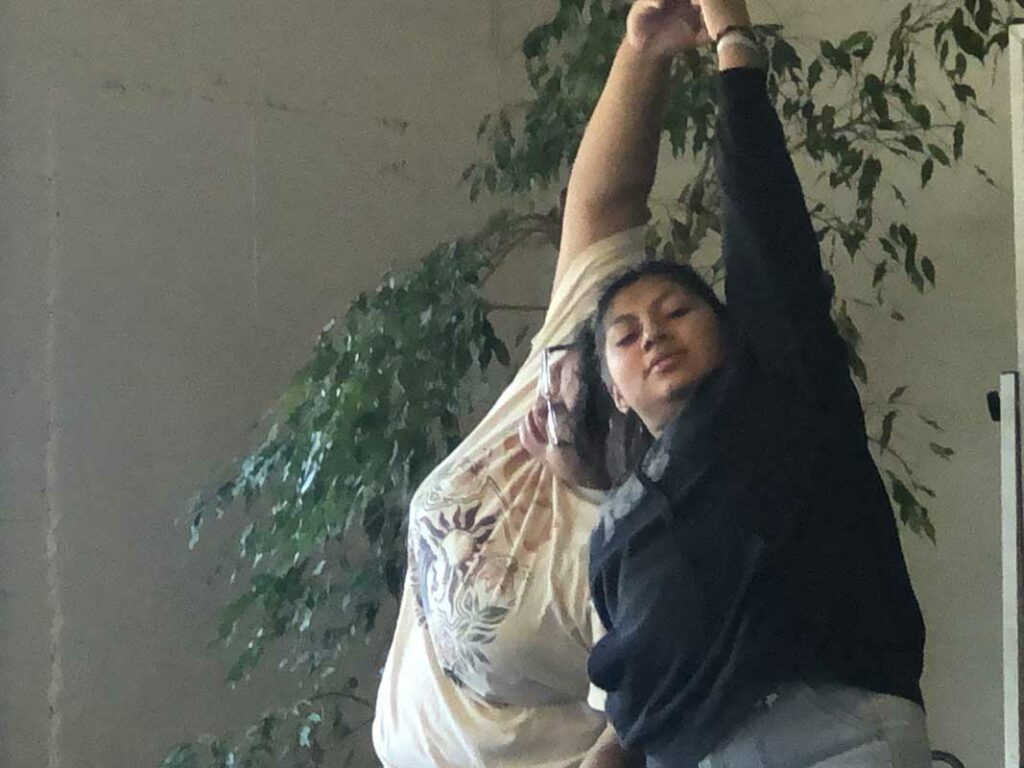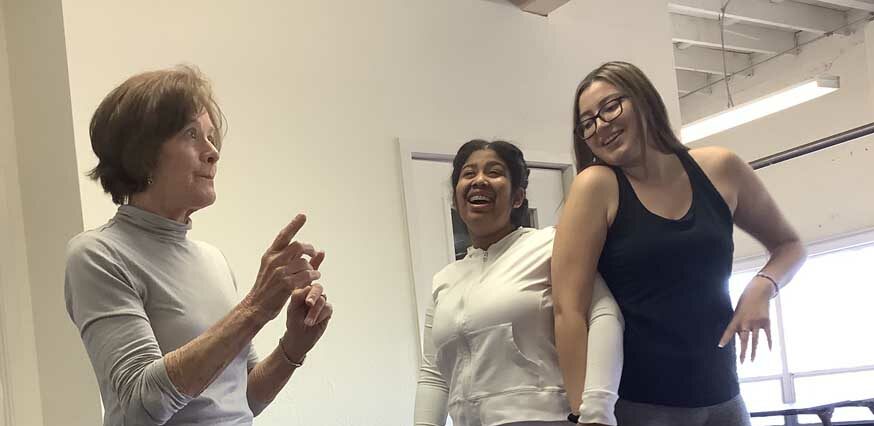Keeps youth accountable, removes shame and stigma
This story was co-published with MindSite News, a nonprofit digital news site focused on mental health reporting.
On a late afternoon in December, a 22-year-old youth advocate named Rachel is addressing a jury of her peers on Zoom in Marin County, California. Her client: a teen named Leonel, who was caught with two boys after shooting BB guns from a garage.
The boys said they were shooting bottles in the driveway, but several BBs hit a neighboring home and passing vehicles, causing damage and broken windows, according to a police report. No one was arrested but police cited Leonel and his friends for vandalism.
A virtual room full of teens and young adults listens intently as Rachel talks about how Leonel is changing his life in the aftermath of the incident.
“As you will hear today, Leonel has made some important changes in his life,” she tells the peer team members, who act as jurors and will question the teen about those changes. She instructs them as jurors to focus their questions not on what he did wrong, but on what he’s doing right. (We are identifying Leonel and other youth court participants by their first names to protect their privacy.)
Welcome to Marin County’s Peer Solutions program, a project of Youth Transforming Justice, and one of approximately 1,400 youth courts in the country that serve as alternatives to the traditional juvenile justice system. California has more than 70 such courts, some convening in schools, others in courtrooms or informal community settings.
“We’re not here to punish or stigmatize,” Don Carney, Youth Transforming Justice’s founder and executive director, tells the peer team members. “Every young person is so much more than the dumbest thing they’ve gotten caught for by some authority figure.”
He urges the young participants to remove judgment as they encourage a sense of safety and consider Leonel’s friendships, interests, and strengths.

The mission of the program and others like it is to counter a trend that became common in the late 1980s of suspending or expelling public school students, especially students of color. Advocacy groups like the ACLU argue that this approach increases absence and alienation from school and increases the risk of arrest and entry into the criminal justice system, fueling the so-called school-to-prison pipeline.
Because more than two-thirds of youth involved in the juvenile justice system have experienced trauma from abuse in their homes or violence in their communities, Peer Solutions combines restorative justice techniques with practices that help youth to feel safe even when facing school disciplinary procedures or criminal charges.
BACK AT THE PEER SOLUTIONS SESSION, THE “JURORS” HONE IN ON ANOTHER FACET OF TEEN COURTS—ACCOUNTABILITY.
Proceedings used to take place at the Superior Court of California in Marin County before they went virtual during COVID lockdowns. The decision to keep them online stems from an encounter Carney had with an undocumented teenager faced with the choice of school suspension or Youth Court. Surprisingly, he chose school suspension.
“When people like me go near Superior Courts, we tend to disappear and get sent back,” he told Carney. With that, “a lightbulb went off” for Carney as he realized how much fear an actual courthouse can inspire.
The online program is also more accessible for its participants since transportation to the court is no longer an issue., Like the in-person court, it revolves around accountability. To fulfill its terms, respondents must volunteer with an organization that meets their interests, participate in future gatherings of the court, and take a 12-hour course. The classes teach them how to steer away from drugs and alcohol, how to be a first responder to a peer who has overdosed, and how to manage an encounter with police in ways most likely to protect their rights and their lives.
This is where the youth really start to trust the program and the staff, Carney says. “We teach them how to talk to an officer in a respectful manner and continue to exercise their civil rights.”
The program also instructs youth on ways to stay grounded if they encounter officers so they don’t feel the need to run.
“First thing, make sure they can see your hands,” Carney says. “As you’re holding your hands up, take three deep cleansing breaths to clear your mind and try to stay still.”
Since its inception in 2004, Peer Solutions says it has diverted 1,300 teens from the traditional juvenile justice system. The vast majority—95%—complete their agreed-upon court tasks, and among those who do, there’s only a 7% rate of recidivism.. Close to 70% of youth who take part are Latino, including a small number of teens who fled from Guatemala as unaccompanied minors. As today’s youth court session begins, Leonel, the “respondent,” is asked by the de facto judge and “facilitator,” retired attorney Marita Daly, to give his version of what happened. Then comes a volley of questions from the peer team and responses from Leonel:
How has the relationship with the people you were caught with changed?
I no longer have relationships with that group of friends. I stopped talking to them.
How do you feel about what you did?
I feel guilty for being there…
What goal do you have right now?
Just to get out of school and start working.
Leonel adds that he plans to become a landscaper, and the questions from the “peer team” soon take a different turn.
Teen Court Effectiveness
A randomized-controlled study of 12 middle schools and high schools that used youth courts, compared with 12 schools that didn’t, found that suspensions declined more than twice as much in the schools that started using them. Use of the courts was also “significantly associated with positive changes in school satisfaction” and (seemed also to lead to a reduction in the number of students saying they had friends who were considered “delinquent”), according to the study, published in 2020 in the Journal of School Violence.
The schools with teen courts also saw a 47% drop in bullying versus a 22% decrease in schools without the courts. The authors concluded that the school-based teen courts “have the potential to positively impact youth development.”
But overall, there’s been relatively little research on the effectiveness of teen courts. A 2023 review by the Rand Corporation, “Promising Services for Justice Involved Youth,” included seven youth-court programs. The 2020 study mentioned above had positive results. So did two others that found youth in youth-court programs were less likely to re-offend than those in other diversion programs and had relatively low arrest rates (20% in a year). Yet another found that a teen court was associated with increased substance use and delinquent behavior among boys and no effect on girls. “Overall, there were mixed results on teen courts’ abilities to reduce recidivism and other outcomes,” the Rand report authors concluded.
Back at the Peer Solutions session the “jurors” hone in on another facet of teen courts—accountability
How did the incident affect you?
I didn’t have any problems with the police [before this happened]. Now I have problems. I have probation. I have a time I have to be home.
Rachel, the advocate, jumps in:
What would you do differently if a similar situation happened?
I’d leave the place, leave the area – not hang out with them.
Heydi Taay, 17, is now a paid intern with the program and has participated as a “juror.” She understands how nervous youth going through the court can feel, having once appeared at a hearing after stealing another student’s ear pods. She especially identifies with the challenges of youth whose parents lost their jobs during the pandemic.
“They were really hurting that they weren’t able to help their parents,” says Taay. “It really touched me personally, because my parents too had lost their jobs then, and they were having a hard time paying for rent and food.”
That dynamic is a driving force of the Peer Solutions program, says Meghan Greenwood, a counselor for San Rafael City Schools. She has observed the peer court in action and later ran one at a local middle school.
What impressed her most “is that they include the students who have been through it as part of the jury,” Greenwood says. They “understand what it’s like to sit in that kind of hot seat. So there’s a lot of empathy.”
That’s a key element for Eric Olson, director of Marin County’s Juvenile Services Division. “One of my biggest concerns with juveniles is, do they have the capacity for empathy?” The Peer Solutions program, he maintains, is key in developing that.
But the program isn’t just about cultivating empathy; the peer-to-peer element also helps build connections.
“This is a very powerful motivator for adolescents, that sense of being connected to one’s community,” says Keith Cruise, director of clinical training in the Department of Psychology at Fordham University in New York.
Another program tenet is that all youth need a trusted adult in their lives. Having one, according to a recent study, is a protective factor that helps offset the harm a child may experience from adversity in the home or community. Carney insists that every referred youth gets asked if they have such a relationship.
“We now know that resilience is really based on having that trusted adult that you’re willing to take advice from,” Carney says.
Leonel had these trusted adults—his parents—but not every teen does. When they don’t, it often falls to Antonio Zavala, the youth court’s 33-year-old director of programs, to try to fill the void.
A Mexican immigrant, Zavala knows firsthand how the lack of such a presence can impact a teen’s life. When he was 10, his mother decided to escape from Zavala’s abusive, alcoholic father and return to Mexico with him and his two siblings. His father refused to let her take Antonio.
“That drove a spear through my mom’s heart, and I ended up having to stay with this man whom I had grown to hate,” he says. By his teen years, Zavala had grown into someone “who was not going to run to his room, scared of what my father was going to do to me.”
He served time in juvenile detention, got kicked out of schools, and was sent to the school of last resort for kids who were troublemakers.
“By that time, I had already been pushed into gangs, I had already found my tribe and there was a lot of violence that I was committing outside of the home,” he says.
Amidst the chaos and violence, Zavala encountered an adult who earned his trust. It was Carney. He organized outings for Zavala and a group of other teens on probation, all of whom, Zavala says, “had come to internalize that we were failures.” Carney took them out to meals and to play basketball and racquetball.
“He kind of told us although these schools maybe don’t want you, although you’re on probation, you’re human and you still matter,” Zavala says.
Through the program, a trauma therapist worked with Zavala during lunchtime, trying to coax him out of the armor he had forged between himself and the outside world.
“She had the ability to get me to talk about an experience that I just went through and get me to really focus on my reaction to it,” he says. “It helped me better understand who I was and do it in a way that felt safe and comfortable.”
Growing up in homes filled with chaos from violence or unpredictable stress can put a child’s brain into a constant state of high alert, ready for fight or flight, Carney told the Peer Solutions gathering.
“When you grow up in those circumstances, it’s a survival asset to know when to fight back, when to disappear,” he says. But, in school or other settings, there’s a downside: “You really quickly get labeled defiant, disruptive and noncompliant…You tend to believe it and internalize it and start acting it out.”
Activities like yoga help young people in the program tamp down their stress and build connections with other youth. It also counts toward community service hours.
On a recent Saturday, yoga teacher Rayner Needleman walked six participants through a series of breathing exercises, yoga poses, and stretches, then had them pair off. One participant, Sonia, said it helped her relax.
“I really liked that we were in a small circle with others,” she said through an interpreter. “When I try to do any form of physical activity, it’s hard because I’m by myself and it’s hard to find the motivation.”

Sonia is almost 16 and loves algebra and mathematics. She came to the United States on her own from Guatemala two years ago. She wasn’t comfortable talking about the reasons for her flight, but she had to leave and now lives with a maternal aunt and uncle. She choked back tears when asked what she misses about her parents, whom she speaks to virtually.
“I liked going for walks with them, just hanging out, going shopping,” she says. “I felt like they really took care of me.”
Smoking in the bathroom landed her a referral to the program and overwhelmed her with fear and worry—until she met her peers and staff. Because of what she endured back home and on her journey to the U.S., the staff worked with her one-on-one rather than asking her to face a roomful of peers.
She also was assigned to work at a food bank, where she learned “to give back to others,” she said. “Seeing people so appreciative of what we’re doing when they receive the food makes me really happy and gives me a sense of purpose.”
Back at the Zoom session, the peer team returns from a break-out room and outlines the restorative plan that Leonel has already agreed to: He will participate in three rounds of jury duty with the peer team and 20 hours of community service in landscaping. He also will pay $500 in restitution for damage to the cars and the neighbor’s house.
Leonel was given three months to fulfill his plan and participate in Youth Transforming Justice’s harm reduction course. “Next time I see you in this setting, I hope to see you as a peer team member,” says Marita Daly, who acted as a judge. “Good luck to you, and remember, you’re a valued member of the community.”
Published in collaboration with MindSiteNews.








